Looking to learn about moray eels? You’re in the right place, we’ve got everything you want to know: diet, habitat, behavior, and more!
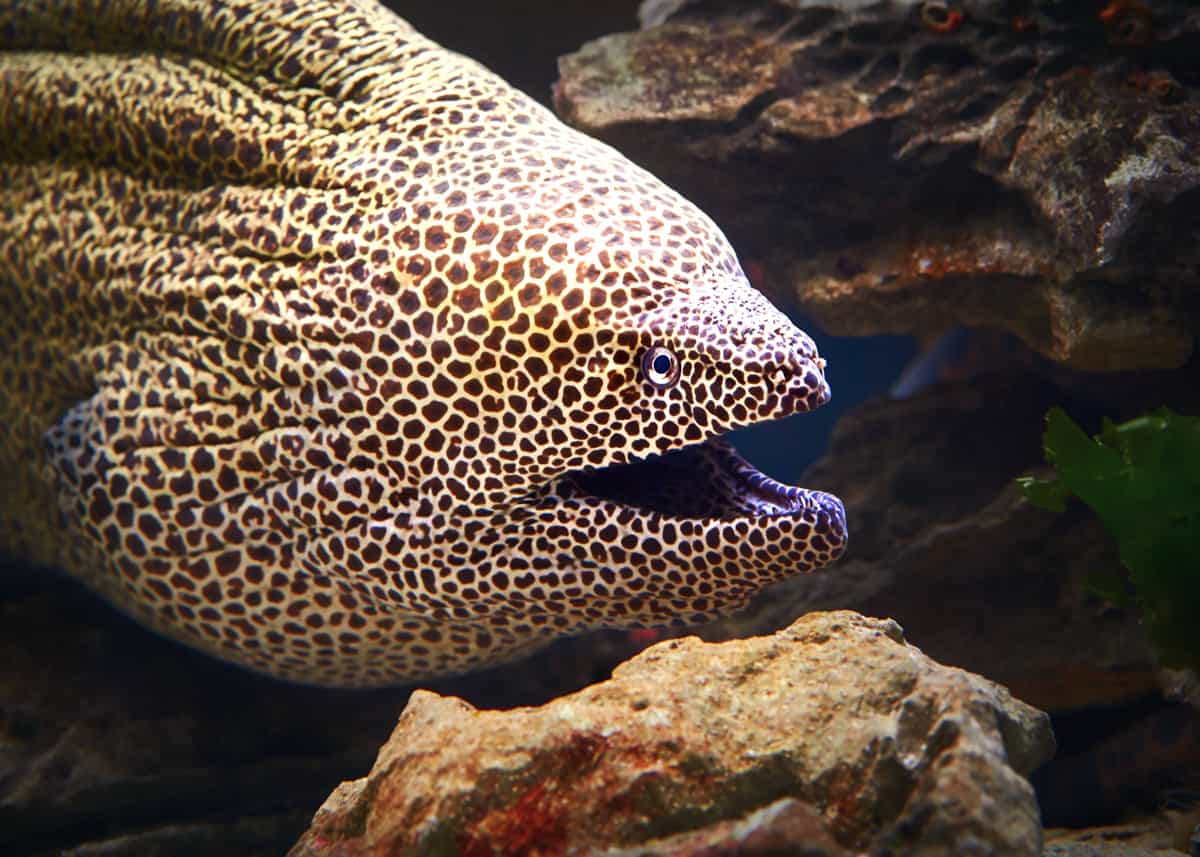
Table of Contents
34 Moray Eel Facts
They have sharp, jagged teeth. They’re covered in toxic slime. They devour their prey with a set of double jaws. They are some scary animals.
Moray eels are some of the weirdest animals in the ocean, but there’s more to the species than their most terrifying features.
For example, they’re actually quite intelligent, and they’ve been known to cooperate with other fish during hunts. You wouldn’t know this if you only listened to headlines about “Murderous Morays.”
Let’s learn some facts about these fascinating fish that you may not have known before.
1. What does the moray eel look like?
Since there are hundreds of species of moray eels, they can run the gamut in terms of appearance.
They can be black, brown, green, blue, yellow or white. They can be spotted, striped, freckled or mottled. They can be smaller than a ruler or larger than the world’s tallest human. They are kind of the definition of diversity.
Despite their differences, however, you can usually tell when you’re looking at a moray eel. They have several big similarities in terms of shape.
For example, all moray eels have a dorsal fin that runs the length of their bodies. They also lack pelvic and pectoral fins, which is one of the reasons why they have such a smooth, serpentine figure. Their body line is unbroken.
Another distinctive feature of the moray eel is the jaw. These creatures have wide mouths with two sets of sharp-toothed jaws that are used for catching and consuming their prey. Yikes!
2. How big is a moray eel?
The smallest moray eel species is the minute moray (Anarchias galapagensis), and it measures just 14 centimeters long.
On the flip side, the biggest moray eel species is the giant moray eel (Gymnothorax javanicus), and it can grow up to 9 – 10 feet long. That’s bigger than both a human and a bottlenose dolphin!
3. How much does a moray eel weigh?
This is another answer that depends on the species. As previously mentioned, the biggest moray eel species is the giant moray, and it can reach a whopping 65 pounds or more.
On the other hand, the smallest moray eel species can weigh just a few ounces.
4. How many species of moray eels are there?
There are more than 200 species of moray eel out there. While they look and function the same, they differ in size, color, diet, and habitat.
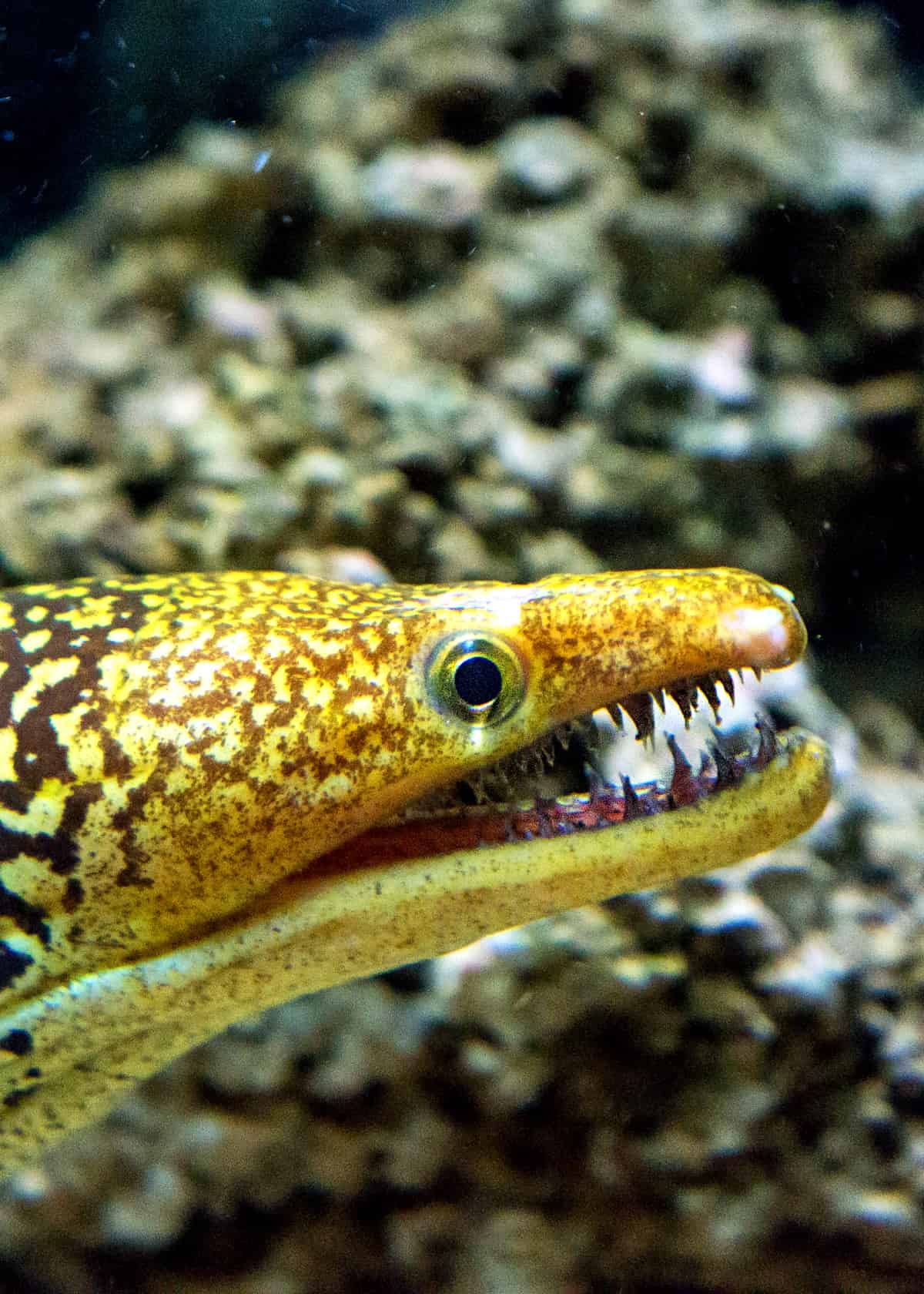
For example, some moray eels live in saltwater while others live in freshwater, and there are some that straddle the line in brackish water.
5. What are the most common moray eel species?
We’d keep you here all day if we tried to talk about every single species of moray eel. If you want some of the highlights, however, here are a few of the most notable species!
- Ribbon moray eels (Rhinomuraena quaesita) have bright blue bodies with yellow jaws. They resemble Chinese dragons with their colorful appearance and high dorsal fins. They’re also suspected of being hermaphrodites that change from male to female as they age.
- Fangtooth moray eels (Enchelycore anatina) have jagged, glass-like teeth that protrude from their first set of jaws. They also have bright yellow heads with brown-and-yellow spotted bodies that give them the nickname tiger moray and birds-eye moray.
- Giant moray eels (Gymnothorax javanicus) are the largest morays by mass. They measure 9 – 10 feet long and weigh an average of 65 pounds. However, Gangetic morays (Strophidon sathete) are the longest morays; the record breaker was 12.9 feet when caught on the Australian coast in 1927. Those are some freakishly big eels!
- Laced moray eels (Gymnothorax favagineus) are also known as leopard morays or honeycomb morays because of the black spots on their white and tan bodies. These spots reflect the amount of camouflage in their environment, so if they live in an area with less coral, they’ll also have fewer spots.
- Golden-tail moray eels (Gymnothorax miliaris), also known as yellow canary morays, are popular among fish owners. They have a visually interesting appearance and are known to be quite active in their aquariums.
- Unicorn moray eels (Echidna unicolor) have ghostly white or tan bodies with dark rings at the tops of their heads.
- Zebra moray eels (Gymnomuraena zebra) have black and white stripes much like a zebra.
- Green moray eels (Gymnothorax funebris) are actually brown. It’s the mucus covering their bodies that gives them a neon green or yellow appearance.
- Snowflake moray eels (Echidna nebulosa) are one of the few moray species that like to feed on mollusks, crustaceans and sea urchins. They have blunt teeth that are specifically designed for crushing through the hard shells of their prey. Other morays go for softer creatures or smaller ones that they can swallow whole.
6. Are moray eels ever confused for other animals?
Due to their smooth, slinky bodies, moray eels are frequently confused with sea snakes. You’ll need to look closer to realize that moray eels have thicker proportions and bigger heads than true water serpents.
On the other side of the equation, “false morays” are a kind of eel that’s commonly mistaken for a moray, but the two species have no genetic relation at all. They simply look alike.
7. How did the moray eel get its name?
Tracing the origins of the name “moray” is a bit like playing a game of telephone. It started with the ancient Greek word muraina, which meant “eel.”
This later became the Latin word mūrēna, the Portuguese word moréia, and the English word moray.
Thankfully, it’s been moray since the 17th century, so it’s unlikely to have any more permutations.
8. What is the moray eels Latin name?
Moray eels belong to the Muraenidae family. Here’s their complete family tree:
- Class: Actinopterygii (ray-finned fish)
- Superorder: Elopomorpha (fish with a certain type of larvae)
- Order: Anguilliformes (eels)
- Family: Muraenidae (moray eels)
Each species of moray eel has its own scientific name. We won’t list all 200 for the sake of your eyeballs!
9. What other names does the moray eel have?
As a species, moray eels are pretty much known as moray eels. There aren’t any special nicknames for their entire family.

Individually, however, you’ll find all kinds of aliases for the different moray eel breeds. For example, the Gymnothorax miliaris is known as the golden-tail eel, conger moray, and yellow canary moray eel.
Enchelycore schismatorhynchus is called the brown moray eel, white-margined moray, and funnel-nostril moray.
10. Why are moray eels covered in slime?
It’s common for eels to secrete a thin, transparent mucus that forms a protective layer over their skin. Moray eels simply generate a lot of it.
It helps them glide through the water in a fast, frictionless way; it helps them build sand burrows by acting as a sort of glue for the tiny sand granules.
It even attracts parasites that bring cleaner shrimp close to the moray eel in hopes of eating them, but unfortunately for the shrimp, they usually get eaten instead. What a life; you try to help a guy out and he just eats you. Jeesh!
11. Can moray eels see?
Moray eels have small round eyes at the end of their snouts. However, their vision is very poor, and they rely on motion and smell a lot more than eyesight when it comes to hunting.
Incidentally, this is one of the reasons why moray eels can nip at people’s fingers as they’re being fed. It isn’t an act of greed or aggression; they just can’t tell what’s food and what’s fingers.
This is a commonly misunderstood thing about moray eels.
12. Are moray eels dangerous?
Yes, but not as much as you might think.
Moray eels have been known to attack surfers and scuba divers, so they aren’t exactly gentle, peace-loving creatures. They’re apex predators that react aggressively when they feel threatened.
Since they can be larger than humans, they’ll definitely make you gasp if they come hurtling towards you in the water.
On the other hand, moray eels have gotten a bit of a bad reputation for things that they can’t control. It isn’t their fault that they’re born with long, snake-like bodies and jagged teeth.
And they can’t be blamed for having poor vision that leads to bitten fingers. That’s just the way they’re made!
13. Are moray eels intelligent?
Yes. While it can be difficult to determine the intelligence of fish species, moray eels are thought to be cleverer than most.
They can cooperate with other fish for hunting purposes, and they can learn the routines of their prey to better stalk them and flush them out.
Some moray eels have even gone on hunger strikes while in captivity. All of these things suggest that they’re operating at a higher level of intelligence than other eels.
14. Are moray eels aggressive to humans?
It depends on the eel. Some can be remarkably docile, especially if they hang around popular beaches and are used to divers and swimmers with underwater cameras.
They’ll let people swim right up to them and take their picture without any acts of aggression.
Note: While what this woman is doing is amazing and I’m glad that it works for her, I do not suggest anyone doing this. Morays are still wild animals and are unpredictable.
The eel in the video could snap, she could get scared or startled – and one time is all it takes. So please be smart with wildlife, don’t swim up to a strong and dangerous predator and expect to be able to cuddle it.
On the other hand, deep-sea moray eels aren’t used to trespassers in their territory, and smaller species can be intimated by larger humans.
This can lead to moray eels attacking humans in the same way that they attack other animals: with a swift, sudden ambush that you don’t see coming until it’s too late.
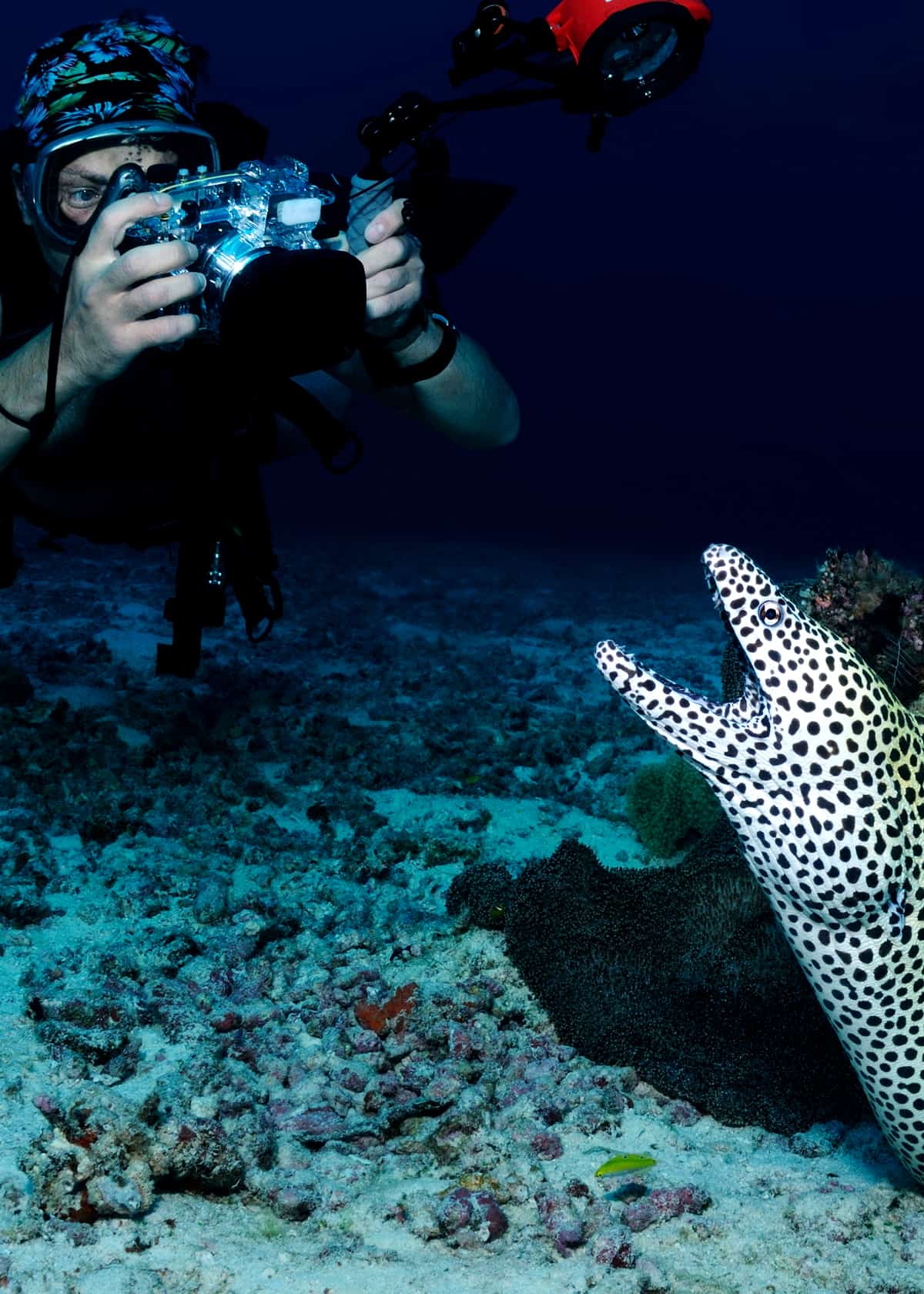
No one has ever been killed by a moray eel, by the way. But there have been some gruesome injuries sustained by them, including flesh wounds and bitten-off fingers.
15. Do moray eels bite?
Yes. Not only do moray eels bite, but they’re really, really good at it. They have two sets of jaws that are each lined with teeth.
They consume their prey by clamping down on them with both sets and dragging the animal’s helpless body down their throat.
16. Do moray eels have two jaws?
Yes. In addition to their front jaws lined with tiny, spear-like teeth, moray eels have a set of secondary jaws called pharyngeal jaws.
They’re located inside of the throat, and they’re thrust forward into the mouth to latch onto prey and drag them backward.
This is quite unusual for pharyngeal jaws; most of the time, they’re just used to break down food and assist with digestion.
Moray eels are the only known animals that use them as an active weapon against their prey.
17. How do moray eels catch their prey?
They start by creeping into a crack, crevice or coral reef. They like to operate as ambush predators that hide before they attack.
Once they smell something tasty, they’ll lash out with a quick, decisive strike and capture their victim using both sets of jaws.
As you can see, the pharyngeal jaws are located so deep within the throat that they’re invisible to the naked eye; it isn’t until the prey is clamped within the first set of jaws that the moray eel mobilizes the second set.
Once the creature is secured, however, there’s no hope for it. Everything about the moray eel’s mouth is a deathtrap.
They even have slits in their skin to release water so that they don’t have to open their mouths and risk their prey escaping.
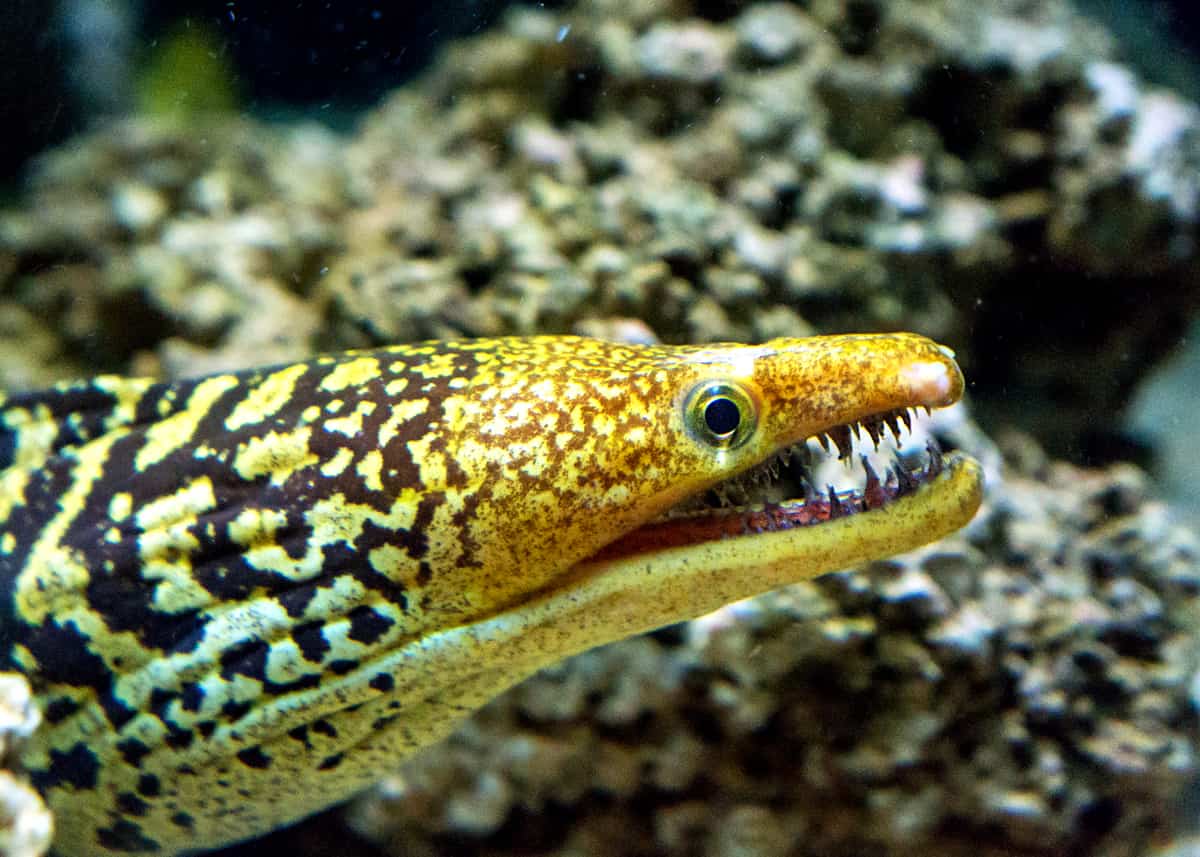
Fun fact: One species, the California moray eel (Gymnothorax mordax), has an extra set of depressible teeth in the tops of their mouths. The teeth fold down as the prey travels backward in the throat.
Not only does this prevent the critter from escaping, but it also protects the eel’s teeth from damage.
18. Why do moray eels “gasp”?
You might see references to moray eels “gaping” or “gasping” with their mouths by opening and closing them for no reason.
On the contrary, however, there’s a very good reason for it. Moray eels have small gills for their body size, so they need to keep the water flowing through them for respiratory purposes.
It’s another move that can be taken as an aggressive one, but there’s nothing predatory about it. They’re just breathing.
19. Will a moray eel hurt you?
Like many animals, moray eels just want to be left alone. You’re much less likely to get attacked if you don’t disturb them or threaten them.
It’s also best if you leave the feeding to professional fish handlers; unless you’ve been trained to spot the signs of a hungry, tired or near-blind moray eel, you run the risk of getting your fingers chomped.
Do not attempt to feed moray eels in the wild. Not only will you increase the odds of an injury or attack, but you might also disturb the delicate balance of their underwater ecosystem.
20. How long do moray eels live?
Depending on the species, moray eels can live anywhere between 10 – 30 years. Unlike some species that automatically live longer in captivity, moray eels can be finicky if captured from the wild and put into tanks.
It isn’t unheard of for a stressed or aggravated moray eel to refuse to eat, and that can affect their lifespan. You know, starving tends to counteract the whole “living” thing.
Captive-bred moray eels don’t usually have this problem, however. The tank is all that they know.
21. What eats a moray eel? Predators and Threats
Moray eels aren’t threatened by much. They’re considered apex predators in their ecosystems, and the bigger species are particularly good at scaring away anything that might attempt to hurt them.

That said, there are a few species that can prey on moray eels. The list includes barracudas, sea bass and sea snakes.
Their large sizes give them an advantage over smaller moray eels. In the case of sea snakes, their smooth and flexible bodies can chase moray eels right into their favorite hiding places. There’s simply no escaping them.
22. Is the moray eel endangered?
No. There are still some moray species that haven’t officially evaluated yet, but the others are all classified as “least concern” by the IUCN.
They’re a widespread species with abundant numbers and lots of genetic diversity. They aren’t going extinct anytime soon.
23. Are moray eels hermaphrodites?
Ribbon morays are thought to be protandrous hermaphrodites that transform from male to female as they mature.
However, this hasn’t been confirmed, and other moray eels don’t share the characteristic. They’re born male or female without any changes along the way.
24. What do moray eels eat?
Moray eels are carnivores that feast on other fish like shellfish and crayfish. They’ll also take down squids, octopuses, shrimp, krill and other forms of sea life.
Certain species of moray eel have flat, blunt teeth that they use to break open hard-shelled crustaceans, but they’re the exception to the rule.
Most moray eels aren’t capable of biting through something like a crab or lobster.
25. Do moray eels hunt with any other species?
Yes! In a fun example of inter-species cooperation, giant moray eels (Gymnothorax javanicus) will sometimes team up with roving coral groupers (Plectropomus pessuliferus) to hunt.
The groupers will recruit them by swimming up to their faces and shaking their heads, or they’ll shake their heads while floating over a bit of coral reef where their prey has slithered into hiding.
The moray eels can maneuver deeper into the cracks and crevices of the coral than the groupers can, so they’ll flush out the prey.
Both the groupers and the morays will snap up whatever comes out.
According to one group of ecologists, this cooperation was the first example of “coordinated hunting” between marine predators. It had previously been observed in mammals and birds only.
26. Are moray eels nocturnal?
Yes, morays are nocturnal. They hunt almost exclusively at night. Since they don’t rely on their eyesight, they aren’t bothered by the darkness.
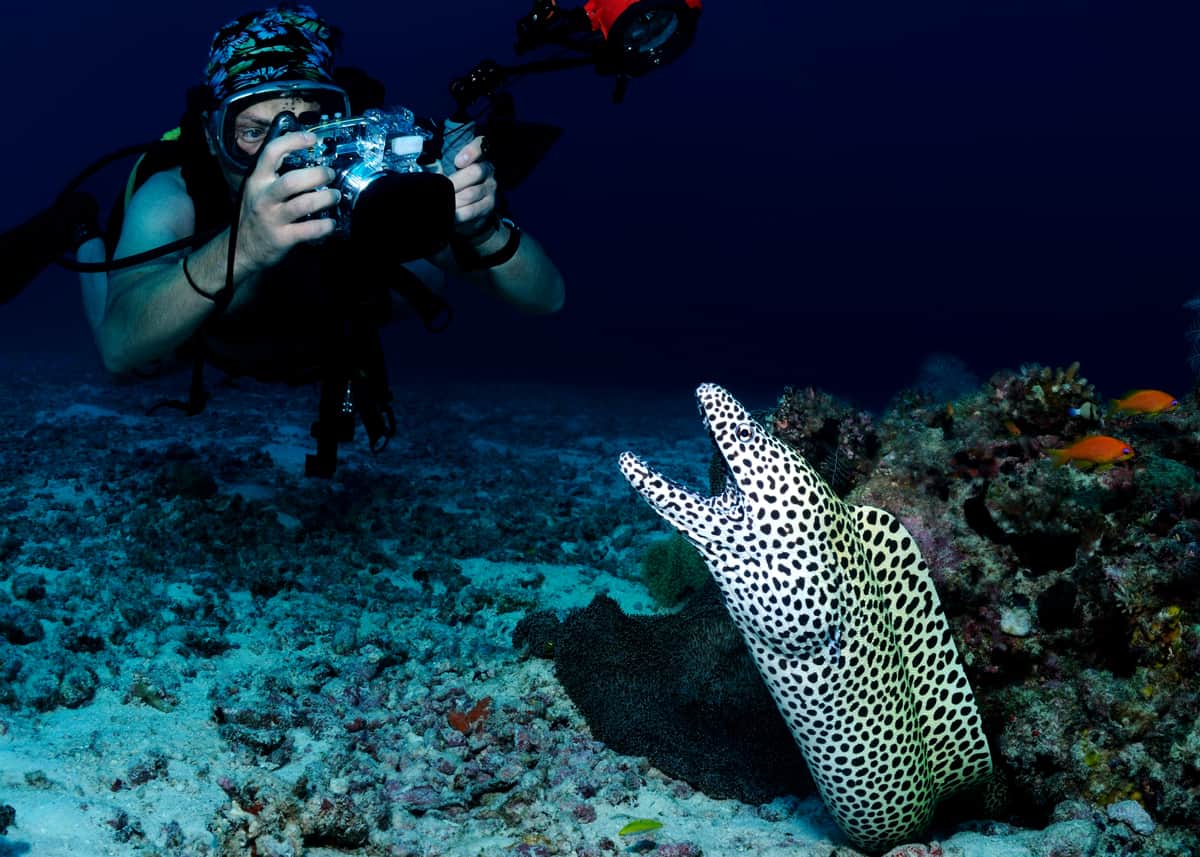
The dark provides coverage from predators as well as better hiding spots for their own ambushes.
27. Do moray eels mate for life?
There’s no indication that moray eels mate for life. Most of them aren’t even monogamous.
28. What does pregnancy look like for moray eels?
Eels lay eggs, and moray eels are among the most prolific of their kinfolk. The Mediterranean moray (Muraena helena) can lay as many as 60,000 eggs at a time!
Some morays lay their eggs in dark, secluded places. Others release their eggs into open water to float freely.
After hatching, all morays spend some time as delicate, jelly-like larvae, and they’ll start growing into true eels after eight months or so.
Mom and dad don’t have anything to do with their children after they’re born. As you might imagine, floating and defenseless larvae make a prime target for predators, and many morays are killed in this stage of life.
The species only survives because of the ridiculous number of overall eggs.
29. Are moray eels poisonous?
Some moray eels are poisonous. The mucus that covers their bodies is toxic, or they carry diseases that can make you sick if you eat them.
30. Where does the moray eel live?
A great number of moray eels live in the Indo-Pacific region.
However, they’re spread all across the world. From the coasts of California to the currents of Cambodia, you can find moray eels just about everywhere.
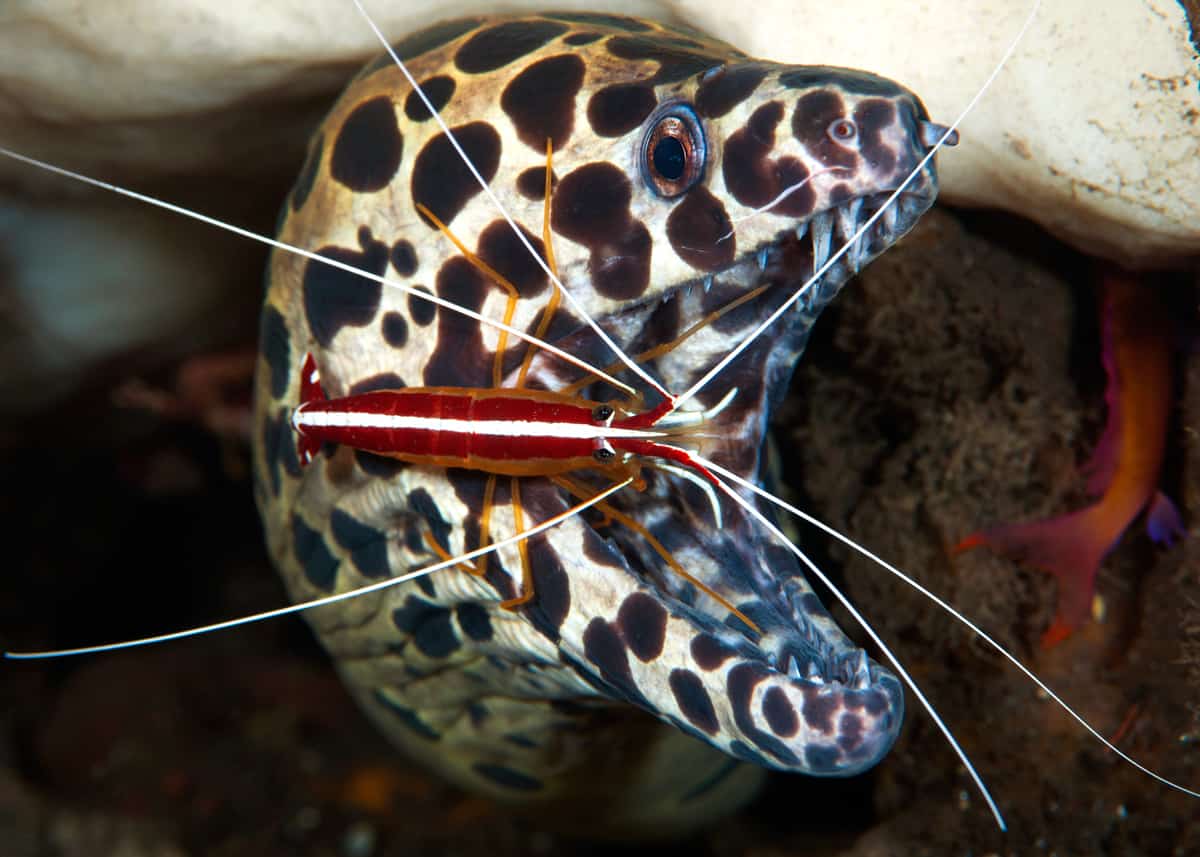
Here are a few common moray eels and their locations:
- Giant moray eels – Africa, Asia, Polynesia
- Green moray eels – Mexico, Brazil, United States
- Pink-lipped moray eels – India, Philippines
- Freckled moray eels – Peru, Galapagos Islands
- Banded moray eels – Great Barrier Reef
- Kidako moray eels – Japan, Taiwan, Hawaii
- Griffin’s moray eels – Australia, New Zealand
There are also rare, unique moray eels that are only found in special places.
For example, the Taiwanese barbel moray eels (Cirrimaxilla formosa) is native to nowhere but Pingtung County, Taiwan.
31. What is the habitat of the moray eel?
The habitat of the moray eel depends on their diet, location, water depth, and species type.
You’ve already learned that some moray eels prefer freshwater while others require saltwater, but there can be many other differences in their environments as well.
Here are a few examples:
- Green moray eels (Gymnothorax funebris) live in shallow waters. They like reefs, rocky coasts, and mangroves where there’s plenty of coverage from predators.
- Mud-dwelling moray eels (Diaphenchelys pelonates) dive deep into the water and inhabit the muddy bottoms of the Pacific Ocean. Even their scientific name reflects this; pelonates means “mud-dweller” in ancient Greek.
- Chain moray eels (Echidna catenata) live and hunt close to the surface. They can survive for around 30 minutes outside of water, and they aren’t afraid to go hunting in shallow shores or tide pools. They can even snatch airborne prey when they’re quick enough.
- Anarchias exulatus hides in the coral reef on the outskirts of islands. Their name, exulatus, means “exiled,” which refers to the fact that they only live on the edges of the Indo-West Pacific.
32. Can moray eel be eaten?
Some moray eels make for good eating. The green moray (Gymnothorax funebris) is said to be tasty, and the Kidako moray (Gymnothorax kidako) is an exotic dish in Japan.
The Mediterranean moray eel (Muraena helena) is covered in toxic slime, but it can be rendered safe after baking or broiling.
Before you pick up a fork, however, you should consider the possibility of ciguatera fish poisoning (CFP). It’s caused by a build-up of ciguatoxins in fish, and it’s commonly found in moray eel livers.
One extreme incident saw more than 50 people poisoned by a yellow-edged moray dish in the Northern Mariana Islands. Two of them actually died from it!
33. Has anyone famous ever died from eating a moray eel?
There’s a persistent internet rumor that King Henry I of England died after eating a moray eel, but this doesn’t have any basis in historical fact.
One chronicler said that he ate too many lampreys. Another said that he simply fell ill after eating seafood. There’s no indication that moray eels played any role in his death. Who knows?
34. Where can I see the moray eel?
With more than 200 species worldwide, moray eels are a common sight. They can be found in zoos, aquariums, pet stores and the oceans outside of your holiday hotel.
If you’re a snorkeler, there are even “aquatic animal tours” that will take you on a journey to popular coral reefs and other hot spots for fish and eels.

My, What Pretty Teeth You Have
With their sharp teeth, slimy skin and beady eyes, moray eels aren’t the most beautiful things in the ocean.
However, you can still learn something from them! Hopefully, these moray eel facts have taught you some cool new trivia to crush your next game night.
What was your favorite fact? Do you still have questions? Let me know in the comments!
Drew Haines is an animal enthusiast and travel writer. She loves to share her passion through her writing.
She graduated high school at sixteen and started her own business, Everywhere Wild Media. And she runs Everywhere Wild and JustBirding. She also guest blogs on Storyteller.Travel
She lived in Ecuador for 6 years and explored the Galapagos Islands. Currently based in N.S., Canada.

Isai Vasquez
Friday 19th of March 2021
How can we tell the defense from a male moray and female moray ?
Rowan
Saturday 23rd of May 2020
I belive that Polychaetes (Phylum: Annalida) also have a pharyngeal jaw that they use to actively grab prey by everting their pharynx.